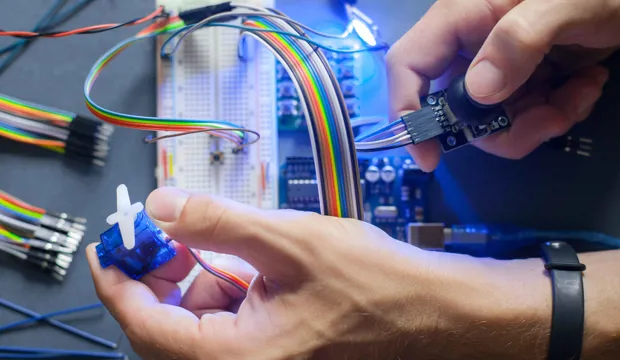
Design an information system
Solve a problem: creating an information display system for disabled people
The importance of smart sensors in our daily routines is growing significantly. The Smart Sensor Communications topic focuses on what smart sensors are, how they are being used today and how they can be innovative in the future.
We are surrounded by systems that convey information but is everyone able to access the information?
Activity: Design an information system
This engaging and thought-provoking activity introduces secondary school students to methods of looking at specific problems. To use the research and knowledge gained to find solutions to a problem, and to allow students to explore these solutions, however improbable they may seem. This activity can be used as part of a ‘Design and make’ activity.
Information systems are all around us. We accept them as part of our everyday life, but do they meet the needs of those who have disabilities?
Students should design an information display system for use in their school which can be used by those with disabilities. For an example of a system diagram use the ‘Systems diagram’ handout.
Students will communicate their solutions using annotated sketches. They should try and identify the Inputs and Outputs that are necessary.
Furnish the students with both information sheets, and explain that any solution should be considered, no matter how crazy or improbable it seems. They will need to produce annotated sketches of a number of solutions – emphasise that these need to be clear so that others can understand. For each solution, a block diagram should be produced showing the Input-Process-Output for the design.
How long will this activity take?
This activity will take approximately 45 minutes to complete.
Tools/resources required
- Woollen gloves
- Blindfolds
- Ear defenders
- Graphical equipment
The engineering context
Engineers play a crucial role in the development and implementation of smart sensors in various industries. Smart sensors are sensors that can process and analyse data, allowing them to make decisions without human intervention. Engineers are responsible for designing and integrating these sensors into systems, ensuring that they function correctly and provide accurate and reliable data. They also play a vital role in the development of innovative ways to use smart sensors to improve various processes, including healthcare, manufacturing, transportation, and many others. With the increasing demand for smarter and more efficient systems, engineers will continue to play a critical role in the advancement of smart sensor technology.
Suggested learning outcomes
By the end of this activity students will be able to identify problems for a specific task, use various methods to research a problem and explore solutions.
Download the free activity sheets below!
All activity sheets and supporting resources are free to download, and all the documents are fully editable, so you can tailor them to your students’ and your schools’ needs.
The activity sheet includes teacher notes, guidance, useful web links, and links (where appropriate) to the national curriculum in each of the four devolved UK nations; England, Northern Ireland, Scotland and Wales.
Please share your classroom learning highlights with us @IETeducation.
Available Downloads

Activity overview
Design an Information System activity description, teachers' notes and curriculum links.

Presentation
Different types of information system and where they can be found.

Handout
Design task challenging students to design an information display system to use in their school.

Handout
Identifying Input-Process-Output - looking at the inputs, processes and outputs required to complete certain tasks.

Handout
Systems diagrams - considering the systems required to carry out various functions.


